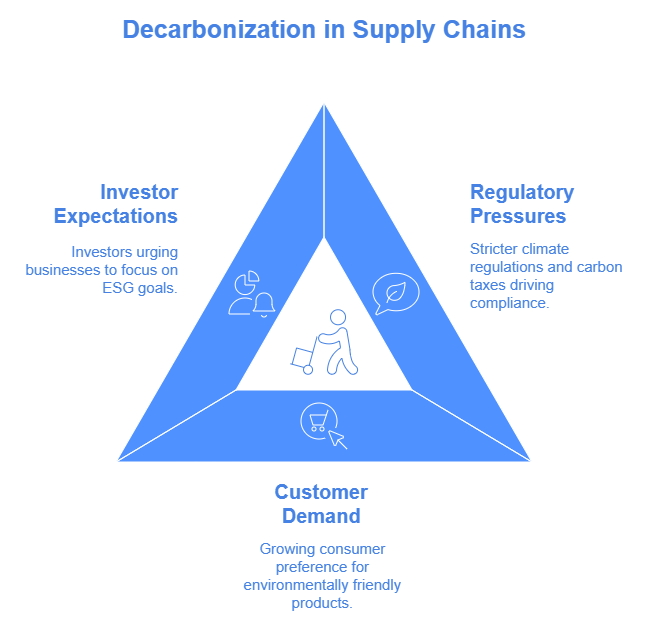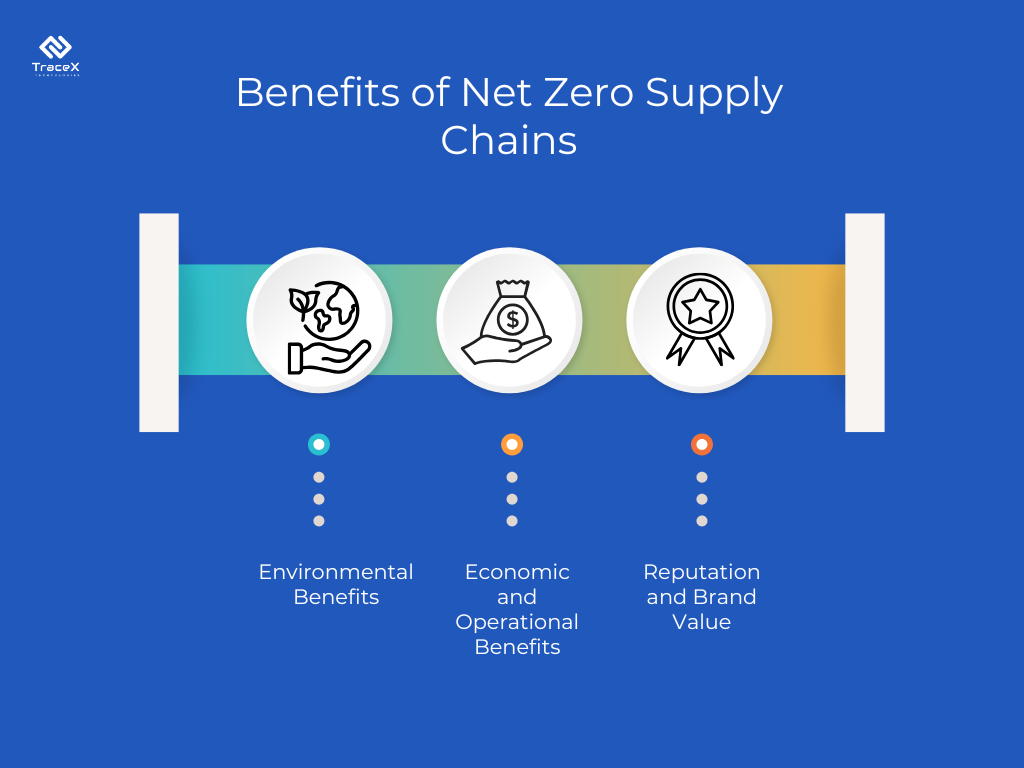Contact: +91 99725 24322 |
Menu
Menu
Quick summary: Discover how net zero supply chains drive sustainability. Learn strategies to decarbonize supply chains, manage Scope 3 emissions, and leverage technology for climate goals.

With the urgent challenge of climate change, businesses face mounting pressure to align their supply chains with sustainability goals. But achieving a net-zero supply chain isn’t just a lofty ideal—it’s fast becoming a non-negotiable demand from regulators, investors, and conscious consumers. For many organizations, the journey to net zero is riddled with complexity
80% of GHG emissions are from Scope 3 and that is a staggering figure that undermines the net zero ambition of an organization that does not measure Scope 3 emissions.
Hidden emissions in Scope 3 categories, fragmented supplier networks, and lack of transparent data are significant barriers to progress. Without the right tools and strategies, even the most committed businesses risk falling short of their decarbonization targets. This blog explores the roadmap to net-zero supply chains, decoding the strategies, challenges, and opportunities that can help businesses turn their sustainability ambitions into actionable results.
Key Takeaways
Net zero supply chains refer to supply chains designed to eliminate or balance out all greenhouse gas (GHG) emissions, resulting in a net-zero impact on the environment. This means any emissions generated are offset by removing an equivalent amount of carbon dioxide from the atmosphere or by preventing emissions elsewhere.
But why is this important? Supply chains are the backbone of how goods and services move from production to consumption. Unfortunately, they’re also a significant source of GHG emissions, with activities like transportation, manufacturing, and packaging contributing heavily to climate change. By adopting net-zero practices, businesses can drastically reduce their carbon footprint while ensuring long-term sustainability.
Did you know that supply chains account for more than 50% of global emissions in many industries? From the energy used in factories to the fuel burned in logistics, these emissions are often hidden but significant.
By focusing on decarbonizing supply chains, companies can tackle the emissions that occur beyond their immediate operations—often referred to as Scope 3 emissions. These are emissions linked to suppliers, transporters, and other third-party partners. Addressing Scope 3 is essential for any business serious about achieving sustainability goals.
Net-zero supply chains aren’t just about doing what’s right for the planet. They’re also about staying competitive. With consumers demanding eco-friendly products and governments rolling out stricter regulations, businesses that lead in supply chain decarbonization will stand out in a crowded market.
Creating a net-zero supply chain might seem challenging, but it’s a powerful way to drive meaningful change. It’s not just about reducing emissions; it’s about rethinking processes, embracing innovation, and contributing to a sustainable future.
Supply chain decarbonization means reducing greenhouse gas (GHG) emissions across all stages of the supply chain—logistics, procurement, and production. It’s about transforming how goods are produced, transported, and delivered to minimize their carbon footprint while ensuring efficiency and sustainability.

Scope 3 emissions are the indirect greenhouse gas (GHG) emissions that occur along a company’s value chain. Unlike Scope 1 (direct emissions from owned operations) and Scope 2 (emissions from purchased energy), Scope 3 includes everything else—like emissions from suppliers, logistics, product use, and disposal.
Scope 3 emissions often make up 70%–90% of a company’s total carbon footprint, especially in industries like food, retail, and manufacturing. That means tackling them is critical for any serious net zero strategy.
Scope 3 emissions are massive, but they’re also incredibly hard to manage.
Managing Scope 3 emissions isn’t impossible—it just requires a collaborative and tech-savvy approach:
By addressing Scope 3 emissions head-on, businesses can unlock significant progress toward their net zero goals while fostering transparency and trust across their value chains. It’s not easy, but it’s essential—and the future of sustainable business depends on it.
Building net zero supply chains isn’t just about cutting emissions—it’s about creating a system that’s efficient, sustainable, and resilient.
Every product starts with raw materials, and sourcing them sustainably is a game-changer. This means prioritizing suppliers who use eco-friendly or low-carbon materials and ensuring ethical practices in farming, manufacturing, and resource extraction.
Technology can do wonders for tracking, managing, and reducing emissions across the supply chain.
Think of technology as your supply chain’s “fitness tracker”—providing real-time insights to make smarter, greener decisions.
Your suppliers play a crucial role in your sustainability journey. Without their participation, achieving net zero can be challenging.
Collaboration is key—it’s about bringing everyone along for the ride.
Logistics and transportation are often significant contributors to emissions. Greening these processes can make a big difference.
These changes not only cut emissions but also reduce long-term costs, making the supply chain both greener and leaner. Sustainable transportation plays a pivotal role in achieving net zero supply chains by reducing emissions through the adoption of electric vehicles, biofuels, optimized logistics, and energy-efficient warehousing practices.
By combining sustainable sourcing, cutting-edge technology, supplier engagement, and green logistics, businesses can build net zero supply chains that are not only environmentally responsible but also future-ready. Every step you take brings you closer to a supply chain that works for both the planet and your bottom line.

Technology is the backbone of building net zero supply chains. From tracking emissions to optimizing resource use, digital solutions are transforming how businesses meet their sustainability targets.
IoT sensors can measure carbon emissions at every stage—from manufacturing to transportation—helping you identify high-emission areas. These sensors also track energy consumption in warehouses and factories, enabling smarter energy use.
For example, smart logistics systems powered by IoT can optimize delivery routes, cutting fuel consumption and emissions.
AI can forecast demand and optimize inventory, reducing waste and unnecessary production. By analyzing usage patterns, AI can suggest more sustainable ways to manage resources like water, energy, and raw materials.
Blockchain technology ensures transparency by creating an unchangeable, shared record of transactions and processes. With blockchain, you can trace a product’s journey back to its source, ensuring it’s sourced ethically and sustainably. Blockchain provides proof of compliance with sustainability standards, helping you build trust with customers and regulators.
For instance, a coffee company could use blockchain to verify that its beans are sourced from deforestation-free farms, meeting both environmental and ethical standards.
TraceX offers cutting-edge solutions that empower businesses to drive sustainability and achieve net zero goals. Let’s explore how the Digital MRV Platform and Sustainability Platform play pivotal roles in decarbonizing supply chains.
The Digital Monitoring, Reporting, and Verification (DMRV) Platform is a powerful tool designed to measure, manage, and verify carbon emissions with precision.
The Sustainability Platform offers comprehensive tools to track and enhance sustainable practices across supply chains. It aligns business operations with net zero goals by focusing on Environmental, Social, and Governance (ESG) metrics.
Building net zero supply chains is no longer optional—it’s a critical step for businesses aiming to stay competitive, compliant, and environmentally responsible. By adopting sustainable practices, leveraging technology, and collaborating with stakeholders, companies can address Scope 3 emissions and achieve meaningful decarbonization. The journey to net zero is challenging but transformative, offering not just environmental benefits but also opportunities for innovation and growth.
A net zero supply chain refers to a supply chain that achieves a balance between the greenhouse gases it emits and the amount removed from the atmosphere, ultimately contributing to global climate goals.
Scope 3 emissions often represent the largest share of a company’s carbon footprint, originating from indirect sources like raw material sourcing, logistics, and product usage. Addressing them is key to achieving net zero targets.
Technologies like blockchain, IoT, and digital monitoring platforms enhance transparency, track emissions accurately, and enable actionable insights for sustainable supply chain practices.
